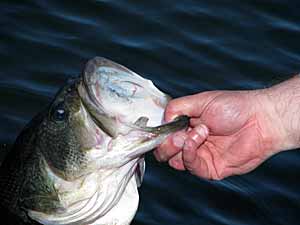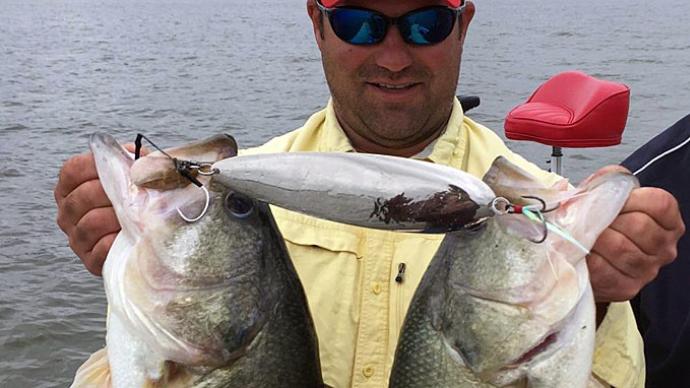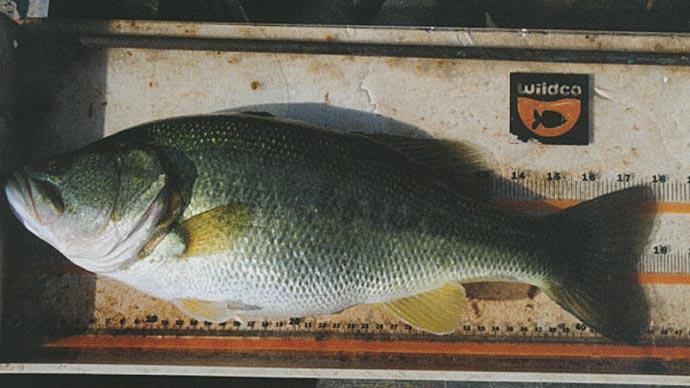
I recently received a communication from my new fishin' buddy, Houston Rankin over in the great State Of Arizona. Houston shared some very difficult news with me. Four bass over 16 pounds had been caught recently, including one that weighed in at 17.47 pounds. This would have made it the new Arizona State Record. According to Houston, the scale at the marina where the fish were weighed was out of certification. Hence, no new State Record.
The 17.47 pounder was caught by Ron Casner, who is entered into Bassin' Magazines Big Bass World Championship. I watch Ron on the Internet and he is always entering large fish in the big trophy contest's we participate in. If the scale is out of certification, I feel for him and the others who caught and released those huge fish. Yet, my suspicion is that we will hear from Ron again, very soon!
Now, I want to caution some of you in regards to these developments in Arizona. Some people may immediately lay blame or try to justify these "certification" challenges. Others might blame the marina where the scale was. Others might take the position that it is not worth it to invest in a certified scale. Regardless, we as fishin' enthusiasts MUST TAKE RESPONSIBILITY. That's correct, if we are going to get these things done right, we need to have a fail proof system in place so when that fish of a lifetime hits, we're prepared! That means RELYING on ourselves. If you have to rely on another person or marina to accurately certify your fish, you're already in trouble. Take responsibility for your own destiny. There are always ways to conform to the rules and regulations of the certification process. Some of these may prove difficult, yet know this: there is always a way. We just need to research it and find it. And I'd bet money there might be an economical way as well!
Houston asked me to comment on these developments and I decided to do some research. If any of you have read my fishin' articles or communicate with me, you know that I keep a "certified" Berkely scale with me at all times. The Berkley is known throughout the industry as a "conservative" scale and in January 2002, I certified a Texas State Record for a Blue Catfish on my Berkley scale. Needless to say, Houston was curious about my methods and that's why he contacted me.
So I launched an investigation into the process. The first question that came to my mind was this: "Would the I.G.F.A. (International Game & Fish Association) certify my Berkley scale that has been certified by a local Dallas scale company?" This one question led me to call the I.G.F.A and speak to their scale master, Mr. Doug Blodgett. I just happened to catch him at the right time for a conversation. Doug was very helpful in answering my main questions as well as others.
Here is what Doug revealed:
First, the Berkley digital scale is okay yet there are others in the market place that might prove to be more accurate. Doug advised that the individual testing company of the Berkely scale and the types of tests that they perform would weigh heavily on its accuracy.
Doug suggested that those fishin' enthusiasts who are chasing trophies might consider a "spring loaded scale" as a more accurate solution. He said there are alternatives that are economical and will work out on the bass boat. Additionally, the I.G.F.A., who on a regular basis certifies scales, claim that spring loaded scales are definitely more accurate.
Doug indicated that he had developed a short, frequently asked question and answer fact sheet about certifying scales. He granted permission to reprint it and here it is:
From Doug Blodgett at the I.G.F.A.:
What are the types of scales used to weigh fish?
There are many types of scales on the market, but only four that are typically used to weigh fish for potential I.G.F.A. records:
- Spring scales ranging from 2 lb. to 100 lb. The better-quality scales are usually made of metal or brass. The most popular scales are made by companies such as Chatillon, Manley and Eastaboga Tackle ("Bogagrip"). Other scales in this group are made by Rapala, Cardoza, and Shimano. Benefits include being easily portable and very sturdy. The wide range of sizes available allows anglers to buy a scale that fits their needs. The only downside is that as the scales get to heavier ranges, they have larger increments.
- "Dial-face" or "Clock-face" scales ranging from 10 lb. to 300 lb. Companies that make these scales are Chatillon, Kenwood, Salter, Detecto and Accu-Weigh. These are generally of excellent quality - very sturdy, with small increments. Weight readouts are easy to read in photographs. Generally, they are not as portable as spring scales and are best used as "permanently affixed" scales. There are small handheld versions available, but they are not nearly as accurate.
- Handheld digital scales ranging from 10 lb. to 50 lb. These are the most common scales. Due to mass marketing, quantity matters more than quality. The most popular are Berkley, Normark and Stren. These scales are generally inaccurate, inconsistent and are damaged if dropped or submerged. Some can be certified, though. There are other manufacturers who stress quality, but at a price. Salter is one of them and there are others manufactured in Europe that are of excellent quality. If people are willing to spend money for these, they also tend to be very careful when using them.
- Heavy-duty digital scales ranging in hundreds to 2,000 lb. These are expensive and accurate, well worth the cost. They are not as easily portable as spring scales, but they have a carrying case. These are for large fish, primarily shark, tuna and marlin. They run on a battery or by electricity. The only downside is the possibility of being caught with no electrical outlets and a dead battery. The only manufacturers I know of in this category are IWS (International Weighing Services) and Cardinal. IWS (previously known as West Weigh Scale Co.) manufactures the Scale Master. Both have a wide range of models to choose from.
What scales can I.G.F.A. certify?
I.G.F.A. can certify scales up to 100 lb. This means that all hand-held spring scales and digital scales can be submitted for certification. "Dial-face" scales in the lower ranges can be certified as well. Those in the higher ranges can be certified by state agencies. Heavy-duty digital scales can be certified (and adjusted) by the manufacturers.
How does I.G.F.A. certify a scale?
Every scale goes through a test where known weights are hung on the scale, and the readouts are noted. I usually test each scale at 5-lb intervals. To be certified, a scale must not be off by more than one increment. Spring scales and "dial-face" scales pass this test for the most part. If the scale does not pass the test, it is usually because of age rather than poor quality. Hand-held digital scales get a 2nd test. I zero out the scale and place a mid-range weight on it. I do this three times. These three tests must match the reading in the first test, meaning all four tests must be the same. If there are any discrepancies from one test to another, then the scale cannot be certified due to inconsistencies. A large portion of hand-held digital scales is not certifiable due to a failure in one or both of these tests.
What scales can I.G.F.A. recommend?
I.G.F.A. cannot recommend any particular brand of scale, but we can recommend a style to give an idea of what is available and what to look for. What works best for anglers depends on how they will be using the scale.
Individuals going out to catch and release fish for potential world records should use hand-held spring scales
They are portable, they are accurate and they are sturdy. It is up to the anglers to determine which scale would work best. They would want to get a scale that is big enough to weigh the fish they are attempting to catch. Using a 100-lb scale (with 1-lb increments) to weigh 5-lb fish would not benefit the angler. Remember, estimated weights are not permitted. If the scale reading is between two marks, the angler must round down to the heaviest known weight. On a scale with 1-lb increments, the angler could lose up to 15 oz. Using a scale that has 1 or 2 oz increments would be the best option for that particular angler.
Certification information:
Only I.G.F.A. members can have their personal scales certified. This includes Associate members, Regular members, Junior members and Lifetime members. Certified Guides and Captains and Certified Weigh Stations can have their scales certified. Of course, it must be no larger than 100 lb.
The cost is $10 per scale. If they ship the scale to us, there is an additional $3 fee to cover Priority mail return postage. If they include a FedEx or UPS number, then the $3 postage fee is waived. Certified Weigh Stations pay no certification fee - it is covered in their yearly membership fee. Certified Guides and Captains pay a discounted fee of $9.
If a member brings in the scale in person, it takes about 5 minutes to certify a scale. If they drop it off, it can be shipped to them or they can pick it up the next time they visit. If a scale is sent in to I.G.F.A., the scale will be on its way back within two business days. Within the U.S., I always ship Priority, so it is usually back in the owners' hands within a week or so.
No state or government agency certifies hand-held scales. Private companies may certify them, and when they do, they charge much more than we do ($60 for the only hand-held scale certification I have seen done outside I.G.F.A.). Considering the cost of a membership and a scale certification ($45-48) is less than the cost of an independent certification, I.G.F.A. offers a great deal with many benefits.
Now, I want to thank Doug Blodgett for his efforts today. He took time from his busy schedule to assist us in this educational process. He did make a request for those reading this article. If anyone has questions in regards to scale certification, please e-mail him at dblodgett@igfa.org and he will be happy to respond to any questions. As soon as I concluded with Doug, I invested into my own I.G.F.A. Membership for $35. I look forward to sending Doug my new scale to be certified! That's correct, a new scale is on its way . . . read on my friends!
After this enlightening conversation and reading Doug's F.A.Q.'s, I went to work on my research. First stop was Chatillon scales. I found various web sites with a few hundred different scales, yet the following web site allows you to directly link to reviews of the most applicable Chatillion products: http://www.itinscales.com/pfishgame.htm.
Next was the Manley scales. After searching on the Internet, I found a very reasonably priced Manley scale located at Bass Pro Shops web-site. This scale is spring loaded and fits the suggestions made by the I.G.F.A. Click here to go directly to BPS' site.
A quality scale with corrosion-resistant brass body and easy-to-read increments. Available in 25 lb. and 50 lb. models, very useful for setting reel drags or weighing the big one. Cylindrical shape allows easy storage. $29.99 38-400-509-00* BRASS 50 LB. Interesting, yet for me, I was not sold just yet.
My third stop was this crazy title for a scale called a "Boga Grip." Boga Grip I asked??? As David's I.G.F.A./ F.A.Q. had indicated, Eastaboga Tackle manufactured this product. After searching the web, I found Eastaboga and called them. They referred me to Burleson Sporting Company who sold the Boga Grips and had inventory in stock. Their web-site is http://www.burfish.com. You can buy them directly at Bass Pro Shops website. It showed a photo of the notorious scale and the web-site indicated they were in stock.
I called their toll-free number which is 1.800.871.5346. I spoke with a Mr. Josh Wesley who took time to explain the features of the scale. The scale handles, weighs, and keeps trophy fish safe. Durable non-rusting stainless steel construction is almost indestructible. Two different models, one for thirty pounders and another one for fifteen pounders. Both sell for only $110 plus $5.50 for shipping and handling. Okay Wesley, I'm in. I'm sold. Let's get the new scale.
Now I wait with anticipation for my new scale. As soon as it arrives, I will in turn send it out to Doug at the I.G.F.A. for official certification.
So, Houston, here we have it. As bass fishin' enthusiasts from Arizona all the way over to the East Coast and across the globe, let's be better prepared for certifying big fish. Let's make the small time and financial investments that are required to certify correctly. Become a member of the I.G.F.A. Let Doug and the gang there help us out. Let's pay attention to details and take individual responsibility for this process. Who knows, someday, somewhere, somebody just might hit that illustrious 22.4 mark and beyond. Let's just hope they're ready!
Chuck Bauer is a noted Big Bass Specialist who has been recognized many times by various organizations, including Bassin' Magazine, Texas Fish & Game, North American Fisherman Magazine, Outdoor Life, Texas Hunting and Fishing News, The Dallas Morning News, and Texas Outdoor Times Magazine. Chuck is a Professional Member of the National Speakers Association and he is on Pro Staff for Kick-n-Bass.
Chuck also does free fishin' seminars in and around the Dallas/Ft.Worth Metroplex.




